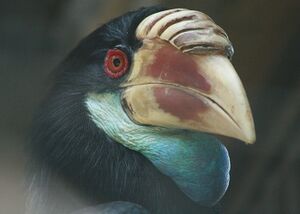Sumba hornbill facts for kids
Quick facts for kids Sumba hornbill |
|
|---|---|
 |
|
| Conservation status | |
| Scientific classification | |
| Genus: |
Rhyticeros
|
| Species: |
everetti
|
| Synonyms | |
|
Aceros everetti |
|
The Sumba hornbill (scientific name: Rhyticeros everetti) is a large and special bird. People on the island of Sumba in Indonesia call it Julang. This bird is part of the hornbill family, called Bucerotidae. It only lives on Sumba Island, which means it is endemic there. Its scientific name honors Alfred Hart Everett, a British person who collected animals and worked in the government a long time ago.
Contents
What Does the Sumba Hornbill Look Like?
The Sumba hornbill is a medium-sized bird. It is mostly blackish and grows to about 70 centimeters (27 inches) long.
Differences Between Males and Females
Male Sumba hornbills have a dark reddish-brown color on their head and the back of their neck. Their neck is a bit lighter in color. Female Sumba hornbills are completely black all over their body.
Special Features
Both male and female Sumba hornbills have a large, dull yellow beak. Near the bottom of the beak, there is a maroon-colored patch. They also have a special part on top of their beak called a casque, which has a jagged edge. Another interesting feature is their throat, which is blue and can inflate, meaning it can puff up.
Where Do Sumba Hornbills Live?
The Sumba hornbill is a bird that only lives in Indonesia. You can find it in the semi-evergreen forests of Sumba Island. This island is part of the Lesser Sunda Islands.
Their Home Environment
These birds are not very common. They live in low-lying areas, usually up to 950 meters (about 3,100 feet) above sea level.
How Sumba Hornbills Behave
Sumba hornbills are known to be monogamous. This means that a male and female pair will stay together for life.
What Do They Eat?
Their diet is mostly made up of fruits. They spend a lot of their time looking for and eating different kinds of fruit in the forest.
Protecting the Sumba Hornbill
The Sumba hornbill is considered a Vulnerable species. This means it is at high risk of becoming endangered in the wild.
Why Are They in Danger?
There are a few main reasons why these birds are in trouble:
- Their habitat (the place where they live) is being lost. Forests are cut down for other uses.
- They only live in a small area on Sumba Island.
- There are not many Sumba hornbills left in the world.
- In some places, people hunt them too much.
What Is Being Done to Help?
To protect the Sumba hornbill, parts of their home are now protected areas. These include the Laiwangi Wanggameti National Park and the Manupeu Tanah Daru National Park. These parks help keep their forest homes safe.


